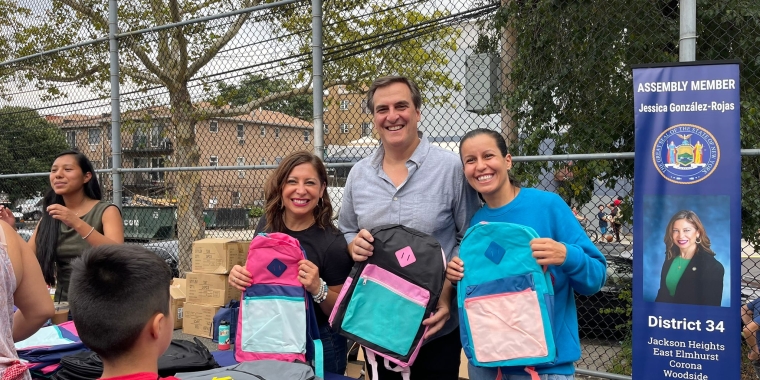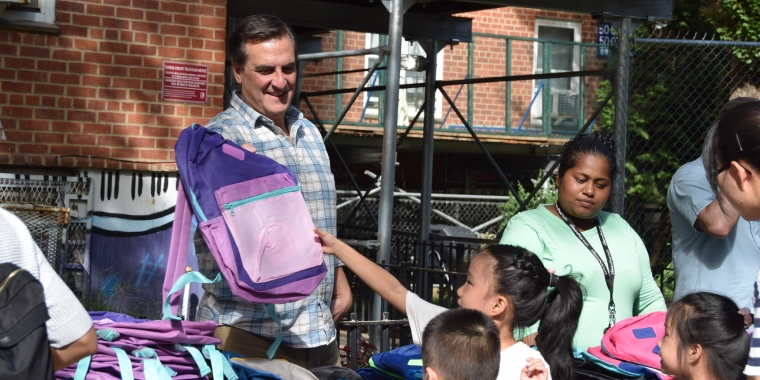
City & State: The fight to recognize the MENA identity

New York considers Middle Eastern and North African individuals to be white. A new bill would change that.
Earlier this year, New York City Mayor Eric Adams completed an interborough tour of mosques for Ramadan and boasted “I’m also the first Persian mayor” during the city’s first Nowruz celebration. (Adams has no Iranian ancestry but was the first mayor to march in the New York Persian parade.) This month, Adams made Fabien Levy the city’s first deputy mayor of Persian or Iraqi descent. On the national stage, even President Joe Biden used the Muslim expression “inshallah” – a commonly used phrase in the Middle East – in a 2020 presidential debate.
Yet despite the established presence of people of Middle Eastern and North African descent, often referred to as MENA communities, in New York and nationwide, their existence is not reflected in federal and state-level demographic statistics. On government records, the community’s footprint lies buried under a mountain of white population data.
Since the 1940s, the United States has classified individuals with MENA ancestry as racially white, a category that rarely matches with the lived experiences or societal perceptions of the community. This year, a coalition of New York-based MENA groups have united around a common goal – proper demographic identification of New York’s diverse MENA communities – and legislators are joining them.
State Senate Deputy Majority Leader Michael Gianaris and Assembly Member Jessica González-Rojas sponsored a bill that would direct the state to separate MENA identities from the white category. The bill’s sponsors said the existing system has severely limited their understanding of the needs of their MENA constituents, resulting in gaps in services.
“I was shocked to learn that members of this community are forced to identify themselves as white,” Gianaris told City & State. “It is offensive to them and does a disservice to policymakers’ abilities to serve these communities.”
The Migration Policy Institute reported that the greater New York City area was home to the largest population of MENA immigrants in the nation between 2017 and 2021, the most recent years for which data was available. A number of neighborhoods in New York City are home to particularly large MENA communities, including Astoria’s “Little Egypt” – represented by both Gianaris and González-Rojas. Yet little official information is available on the city’s ethnic enclave since the census classifies MENA individuals as white.
“What I see is that my district is 27.6%, white, and I know folks who identify as MENA do not live as white people, and they don’t benefit from white privilege,” González-Rojas said. “There are multiple language needs and multiple challenges that they face in terms of civil rights – we’re still feeling the repercussions of 9/11 – and we still see a lot of discrimination.”
The bill unanimously passed the state Senate in June but was stuck in committee in the Assembly. González-Rojas said the bill had not faced any opposition and blamed budget delays and the prioritization of other bills for its failure to pass the Assembly. She is hopeful that the bill will pass the Assembly when the state Legislature reconvenes in January.
With similar state legislation signed in 2021 to disaggregate state data on Asian Americans and Pacific Islanders, and increased minority representation reflected in the new Asian-majority City Council district in southern Brooklyn, the bill could give greater recognition to MENA communities across the state.
“I think that it’s a step forward for us to declare and assert our identities in ways that we haven’t been able to do,” said Linda Sarsour, the former executive director of the Arab American Association of New York and a longtime advocate for census reform. “Particularly from the perspective of data and demographic information, we’ve been basically erased. We’re invisible.”
Federal classifications
MENA individuals rarely fit neatly into the U.S. government’s system of racial classification, which has traditionally been built on a dichotomy of “white” or “Black.”
An intercontinental contiguous land mass, the MENA region is home to a wide array of races, ethnicities, languages and cultures that vary in degree of relation to one another. Yet, the U.S. government has historically treated this region as a racially homogenous and culturally unified group of people.
In the 1942 citizen naturalization case of Ahmed Hassan, the U.S. Supreme Court expressed doubts about “Arabians” racial makeup citing the nationality code, which limited citizen naturalization to members of white, African and Native American groups. But just two years later in the case of Mohamed Mohriez, the court granted citizenship to the petitioner, establishing a legal precedent identifying all individuals of MENA descent as racially white. In the subsequent 80 years, MENA individuals have been instructed to identify themselves as white on official government documents, despite a growing body of research that many do not benefit from white privilege and do not self-identify as solely white.
For generations of MENA individuals, their government-prescribed white identity has not protected them from experiencing post-9/11 xenophobia, targeted surveillance from the NYPD or a spike in Islamophobic hate crimes in 2015. But it has disqualified them from a large portion of minority-focused government programs.
While legislation to amend the federal standards for collecting ethnic data was proposed under former President Barack Obama, it was later ditched under former President Donald Trump, who instead followed through with his 2016 presidential campaign promise to impose a Muslim travel ban. As of late, President Joe Biden has reintroduced the idea, creating a working group – the Interagency Technical Working Group on Race and Ethnicity Standards – whose recommendations may result in a separate MENA ethnicity question on the 2030 U.S. census.
But New York lawmakers are eager to move forward on the state level. “I think we can’t wait,” González-Rojas said. “We need this data now, and we need to make sure that we’re adequately serving the needs of our communities in New York state.”
Supporting MENA communities
Since the state considers MENA New Yorkers to be white rather than part of a racial or ethnic minority group, they have largely been left out of the recent waves of initiatives calling for the diversification of governmental and corporate bodies through MWBE certification and DEI initiatives. “The one thing that will be really important for our North African vendors is to be recognized as minority owners of businesses,” said Mohamed Attia, the managing director of the Street Vendor Project at the Urban Justice Center.
The bill sponsored by Gianaris and González-Rojas would not directly impact the minority status of MENA communities, but supporters said it would serve as an important first step in understanding the needs of the community. “The purpose is, as an initial matter, to get accurate information about these communities, as lumping them in with the white population is giving us inaccurate data and myths,” Gianaris said.
With state data reforms for MENA populations potentially on the docket next year, advocates were hopeful that years of collective advocacy will amount to something tangible for New York’s MENA community. It could even pave the way for other states and the federal government to better understand the needs of MENA citizens.
“To see the fruition of it – and for New York to lead and say, ‘it may not happen federally, but we’re going to do it in New York’ – is just a testament to the work that has been done by many leaders in the MENA community who have been pushing for this,” Sarsour said.

